Skydive!
A story of my first tandem skydiving experience
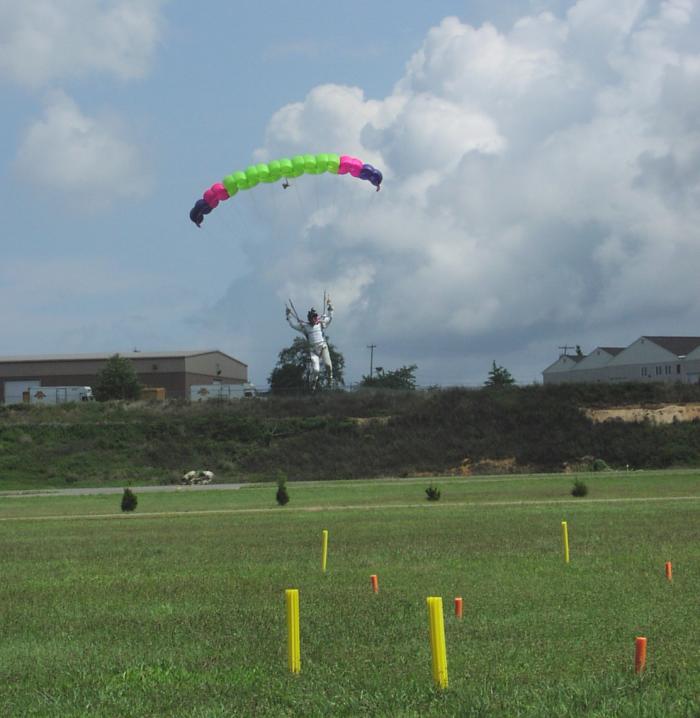
Flight Dynamics
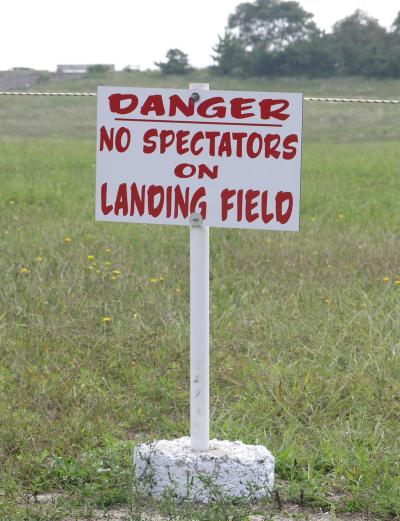 Back in
college, I took two "Flight Dynamics" courses, during which I
picked up about 25 hours flying the CAP10B aerobatic taildragger.
Flying this aircraft was the most fun I'd ever had (in an
airplane!), but the aircraft had a serious purpose too -- to
expand my knowledge of aircraft design, stability, and control,
and apply that knowledge "experimentally" in our
high-performance, real-world laboratory.
Back in
college, I took two "Flight Dynamics" courses, during which I
picked up about 25 hours flying the CAP10B aerobatic taildragger.
Flying this aircraft was the most fun I'd ever had (in an
airplane!), but the aircraft had a serious purpose too -- to
expand my knowledge of aircraft design, stability, and control,
and apply that knowledge "experimentally" in our
high-performance, real-world laboratory.
At the beginning of the first course, we learned the basics of flying an aerobatic aircraft, as well as the emergency procedures unique to this aircraft. Part of those emergency procedures involved learning how to properly wear and operate the emergency parachutes required to be worn by both instructor and student during aerobatic operations per 14 CFR Part 91. Our class was particularly fortunate in that one of the students was an experienced parachutist, and contributed a lot of "real world" knowledge regarding the design and operation of the parachutes.
The course instructor told us stuff an experienced aerobatic instructor would know, like "don't release your seatbelts until you have pulled the emergency canopy release and pushed it clear of the aircraft", "make sure you have a firm hold of the aircraft before you step into the relative wind", and "step out onto the wing (or what's left of it) and drop off the trailing edge". But that's where the aerobatic instructor's worldly knowledge ended.
The student, on the other hand, was able to give us more critical details of what to expect AFTER we'd exited the aircraft. "This chute is what we call a hankerchief...it has a relatively small canopy designed simply to slow you from terminal velocity to a survivable touchdown speed. It is not steerable in the traditional sense and it is likely you will limp away from the drop zone, if you walk at all". He also pointed out that it's critical to have the parachute fastened very securely around your body -- not so tight as to prevent proper circulation, but tight enough that the straps will shift inappropriately when the canopy deploys. You can be injured if it's not properly fastened.
I found a lot of this information fascinating. Fortunately, like most emergency training I receive, I never used it in real life. I have traditionally succeeded in logging one landing for each takeoff. Until recently, that is.
Don't Tell Mom
 A
college buddy of mine, Todd, recently copied me on an email he
was using to coerce his friends to try a freefall skydive. My
initial reaction of "would like to, but shouldn't" wasn't born of
fear -- as I'm fully aware of how safe modern skydiving is -- but
of financial prudence. Two years ago I'd put myself on the fast
track to the ATP certificate, and I wondered how I could justify
money that wouldn't get me another hour closer to the ATP. This
was a matter of priorities, after all.
A
college buddy of mine, Todd, recently copied me on an email he
was using to coerce his friends to try a freefall skydive. My
initial reaction of "would like to, but shouldn't" wasn't born of
fear -- as I'm fully aware of how safe modern skydiving is -- but
of financial prudence. Two years ago I'd put myself on the fast
track to the ATP certificate, and I wondered how I could justify
money that wouldn't get me another hour closer to the ATP. This
was a matter of priorities, after all.
The wheels of justification started to turn, however, and I quickly realized that I could use a jump to bridge a gap in my knowledge that might come in very handy during my upcoming reintroduction to aerobatics in prep for the ATP. For the same reason that I think all student pilots should be exposed to spins, I think it's critical that anyone who wears a parachute be ready and able to use the chute should the need arise. The point at which you break the airplane and need to punch out is NOT the time, I reasoned, to find out how strong a 100+K relative wind really is, and what freefall is all about. I'd also recently celebrated my 35th birthday, and I figured if nothing else I could justify it simply as a birthday gift to myself. After all, I'm halfway to the grave, so why not live until I die, right? :-)
In a couple days, I replied and told Todd I'd be there, and asked him to confirm the date he had scheduled. With his usual offbeat sense of humor he replied, "The correct date for our obituaries is July 31st, 2004. Yours in poor judgement, Todd.". Uh, okay. I'm there!
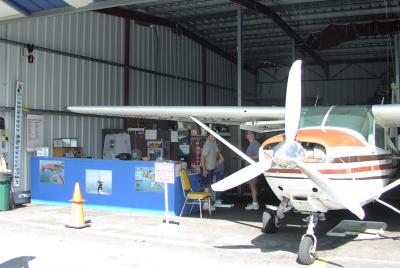 Then
I made the most critical mistake of my life. :-) At my 35th
birthday party, I told my mother about my plans. Point of
reference for anyone contemplating skydiving or anything that
might be perceived (justified or not) as "risky behavior". Never
tell the woman who brought you into this world you that you're
going to do something that might result in your early departure
from it. She'll never understand your justification for said
behavior, and no matter how open minded, she'll never 100% agree
with your decision. Such are mothers at times...and appropriately
so.
Then
I made the most critical mistake of my life. :-) At my 35th
birthday party, I told my mother about my plans. Point of
reference for anyone contemplating skydiving or anything that
might be perceived (justified or not) as "risky behavior". Never
tell the woman who brought you into this world you that you're
going to do something that might result in your early departure
from it. She'll never understand your justification for said
behavior, and no matter how open minded, she'll never 100% agree
with your decision. Such are mothers at times...and appropriately
so.
Skydive Jersey Shore
Todd scheduled our group of six to meet at Skydive Jersey Shore (SJS) located at Monmouth Executive Airport in Monmouth County, New Jersey, for the orientation meeting shortly after 9AM. The office turned out to be tucked in the corner of a row of T-hangars, shared with their Cessna 182 and 205 jump aircraft. The office also contained a small seating area with some couches and chairs oriented toward a TV and VCR.
After some brief introductions and chatting, the school manager asked us to have a seat and explained that before we could jump, we'd need to watch an orientation video and sign a legal waiver that absolved all parties, including the manufacturer of the tandem harness we'd be using that day, of any liability. We also agreed not to sue anyone, and (because any good attorney knows agreements like this can ALWAYS be challenged), we also agreed that if we did sue, we'd pay everyone's legal bills. I lost track of the number of times I wrote my initials and signed my name, but the process is a necessary evil and is over in about 30 minutes.
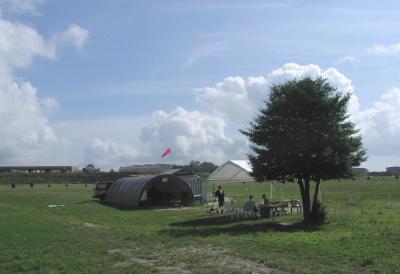 We brought the paperwork
back to the office desk and each of us were weighed in turn.
Weighing is necessary because there are weight restrictions on
who can jump, primarily influenced by the size of the canopies
available at the drop zone. In the same way that an aircraft wing
of a given area asked to bear a higher weight will stall at a
higher speed, so will a canopy, the obvious difference being that
aircraft have landing gear far stronger than a human's and wheels
roll nicely at high speed, while feet do not. Can you say "face
plant"?
We brought the paperwork
back to the office desk and each of us were weighed in turn.
Weighing is necessary because there are weight restrictions on
who can jump, primarily influenced by the size of the canopies
available at the drop zone. In the same way that an aircraft wing
of a given area asked to bear a higher weight will stall at a
higher speed, so will a canopy, the obvious difference being that
aircraft have landing gear far stronger than a human's and wheels
roll nicely at high speed, while feet do not. Can you say "face
plant"?
After the formalities were over, we all walked over to the drop zone and gathered for our first ground school lesson in skydiving.
Jump 101
There are two popular ways you can go about your first jump...you can either do a tandem jump, or start the Accelerated Free Fall (AFF) program. In the tandem jump, your jumpmaster wears the parachute, your harness straps to his, and you jump and land as a single unit. In the case of AFF, however, you wear your own chute and jump together with your instructor, but you separate prior to the point at which you pull your own chute and you land by yourself with appropriate coaching on the way down.
Tandem jumping presents risks that AFF does not, but it is generally considered a wise choice for a first jump, and based on my personal experience I'd have to agree with that. AFF requires that you take a first jump course (approximately 5 hours of ground instruction) while the first tandem jump requires only about 15 minutes of basic instruction since the jumpmaster is in full command of the situation and you're more or less along for the ride.
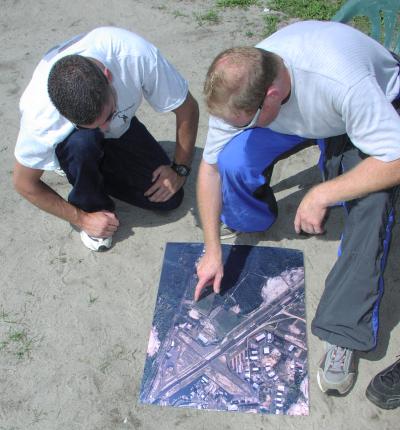 Shortly after we
arrived at the drop zone, one of the jumpmasters asked us to
gather around a simple mockup of the aircraft cabin and
efficiently demonstrated how we would sit in the aircraft for the
climb to altitude, how we'd reorient ourselves so each jumpmaster
could attach his harness to his student's and, most importantly,
how we would egress the aircraft when the time came. With that
out of the way, we had our last chance to chicken out, but by
this time we were all stoked and ready to jump.
Shortly after we
arrived at the drop zone, one of the jumpmasters asked us to
gather around a simple mockup of the aircraft cabin and
efficiently demonstrated how we would sit in the aircraft for the
climb to altitude, how we'd reorient ourselves so each jumpmaster
could attach his harness to his student's and, most importantly,
how we would egress the aircraft when the time came. With that
out of the way, we had our last chance to chicken out, but by
this time we were all stoked and ready to jump.
Suiting Up
SJS provided simple jumpsuits for us, and before long an assistant had completed the initial fitting of our portion of the tandem harness. It's the kind you step into, right leg, then left leg, followed by right arm and then left arm. It's hooked together in several places and then the straps pulled appropriately tight. My instructor Willie then arrived, introduced himself, and proceeded to recheck the harness. He snugged it down a bit more in places, and ensured all of the ends of the straps were properly secured to prevent them from flapping around in the 120 MPH freefall.
Based on my experience with the emergency chute in the CAP10B, I was surprised at how loose the tandem harness felt. When putting on the emergency chute we were taught to squat and pull the leg straps tight until we could not stand straight up. With the tandem harness however, I never lost the ability to stand up straight. In fact, I could easily bend backward. I'd almost describe it as comfortable as compared to the emergency chute.
When I asked why it seemed so loose, Willie said it was because I needed the flexibility to put my body into the "arch" -- the natural freefall body position skydivers use to keep themselves on their belly. The effect is a lot like a shuttlecock. As long as you keep your pelvis lower than the remainder of your body and keep your arms and legs in the proper position, even if you fall out of the airplane on your back, you'll wind up on your belly in short order. Hmmm...aerodynamics for the human body. Cool!
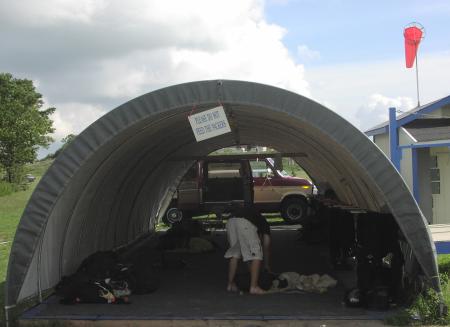 No matter,
of course, since I was quite confident that everything was as it
should be. When Willie told me he's active in the Airborne, I
realized this wasn't just a weekend gig for him...it was his
business.
No matter,
of course, since I was quite confident that everything was as it
should be. When Willie told me he's active in the Airborne, I
realized this wasn't just a weekend gig for him...it was his
business.
Don't Feed the Packers
While we assembled at the back of the shack to hop into the van used to transport to the waiting jump aircraft (in my case the Cessna 205), I watched some of the packers perform their own artistic form of origami.
When Willie mentioned that part of being a skydiver is learning to pack one's own canopy, I was immediately intrigued by the prospect of learning how to do that. It's always been something of a mystery to me how they manage to cram something so large into something so small! Also, truth be told, I'm something of control freak, and after sufficient instruction and practice, I think I'd be happiest packing my own chute as much as I know I would be happiest pulling my own ripcord. But, I figured, all in time. Let's get through the first jump first, shall we?
Let's talk a minute about shop safety
We were just about to hop into the van when someone said "hey, that airplane just crashed". Everyone immediately turned to look over at the runway and we saw nothing. The eyewitness then explained that he saw one of the banner towing aircraft grab a banner, pitch up, wag its wings a bit, then dip a wing and go down behind some hangars. One of the jumpmasters grabbed his cell phone and called over to a friend at a hangar on the other side of the field and said "hey, we just saw someone crash over by the T hangars.....no, I'm not kidding....it's a banner tower".
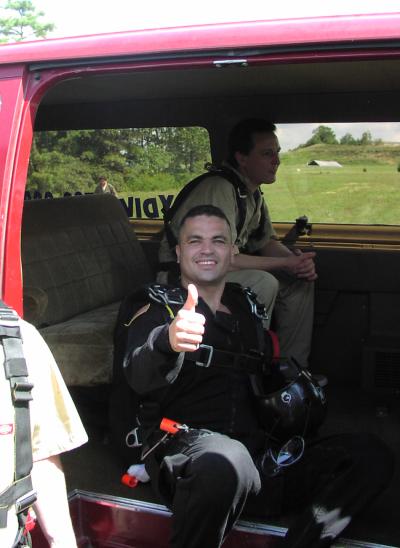 To make a long
story short, the guy totaled the airplane, but walked away with
very minor injuries. When we heard that, everyone, including
three of us who were pilots, breathed a sigh of relief. Then one
of the guys remarked "looks like that guy took the bad luck for
us". While I don't believe in luck, the accident did bring to
light that as imperfect beings, the decisions we make and
processes we follow can have a dramatic impact on the outcome of
everything we do.
To make a long
story short, the guy totaled the airplane, but walked away with
very minor injuries. When we heard that, everyone, including
three of us who were pilots, breathed a sigh of relief. Then one
of the guys remarked "looks like that guy took the bad luck for
us". While I don't believe in luck, the accident did bring to
light that as imperfect beings, the decisions we make and
processes we follow can have a dramatic impact on the outcome of
everything we do.
Professionals such as those in aviation and skydiving do everything in their power to ensure the highest degree of safety, while fully acknowledging that nothing we do in life...even the fun stuff...is or can ever be made 100% safe. But, therein lies a good life lesson: in order to appreciate life, you have to live it and take any and all calculated risks. To expand on an old adage "no one ever got rich on a salary", I'd suggest that no one can live a rich life trying to play it safe all the time. And what better way to live life than to jump out of a perfectly good airplane and experience the ultimate freedom of freefall! :-)
Go Time!
The normal drill is to fit four jumpers (or two tandem pairs) into the 182, or five jumpers into the 205. Because we had a videographer joining us on this hop, I went in the 205.
While a small airplane might freak someone out, as a pilot I found this to be old hat, in spite of the fact that I was sitting on the floor where the copilot's seat would normally be, with my back to the instrument panel. I had a decidedly different seat than usual, and this one didn't have as near a good a view. Of course, it was good enough to watch our takeoff and spiraling climbout over the airport.
By 5000 feet, all the familiar ground reference points, including the coastline, were visible, and I thought about how I often pass right over this very spot at 5000 feet in the comfort of our 172 on a nice, cozy instrument flight plan. Uh, not today bud! The bases of the clouds were around 3000 feet and the tops reaching around 5000 as best I could tell. The deck was scattered for the most part, but appeared to be denser in areas. Just like he said he would, Willie asked me how I was doing every few minutes, and we chatted the best we could over the roar of the engine.
Near 8000 feet I stole a glance at the aircraft altimeter and compared it to Willie's altimeter to find them perfectly in agreement. I also noticed that the 205 was struggling to make 400 FPM upward burning 18 gallons per hour, but like a good soldier, she kept climbing. Around that time Willie told the pilot we'd be doing our thing in five minutes. Willie asked me to turn around and kneel facing the instrument panel as I was instructed on the ground, and he proceeded to connect and tighten all four attachment points. Tugging at each point he said, "You're now attached to a parachute, *here*, *here*, *here*, and *here*." Of course, the harness is designed such that one of the attachment points is more than enough to keep me one with the canopy, but redundancy is a good thing! Willie shouts, "Doug, you ready to Skydive???" I look back at him and say "You betchur ass!" For a moment I feel I've really joined the Airborne elite when he responds with, "HOOAH!"
Stepping Into Infinity
As we neared our jump altitude of 10000 feet, Willie asked me to unlock the door so he could take a peek at the drop zone. The door then popped open and I was given a first hand view -- straight down into infinity. Now, I must be honest with you -- that raised my eyebrows for a couple seconds. I don't have a fear of heights (I'm a pilot, after all), and this is not the first time I've looked down at the earth from two miles up, but staring down into that infinity with nothing between me and it made my heart race. I looked up at the familiar instrument panel, then over at the pilot -- who happened to glance back with a grin of acknowledgment on his face -- and back down at the clouds a mile or so below. I took a couple of deep breaths and briefly thought about how I arrived at this exact moment in time. What was I thinking? :-)
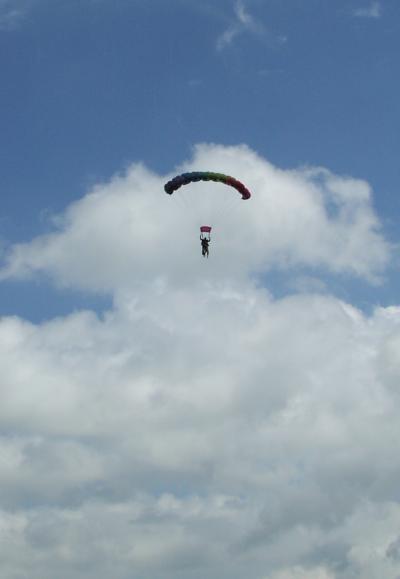 There were clouds over the drop
zone, so Willie closed the door and asked me to lock it. He
proceeded to coach the pilot through a few turns and then told
him to call 1 minute until jumpers away. With the door closed and
my eyes back in their sockets, I got a brief reprieve to collect
my thoughts. Before I knew it, though, the door was open again,
this time latched the underside of the wing, and I could feel
Willie inching himself toward the inevitable. Willie then tapped
me on the shoulder, which was my cue to put both hands on the top
of my harness, stick my head out into the hurricane force wind,
and put my right foot out onto the waiting platform built over
the right main wheel.
There were clouds over the drop
zone, so Willie closed the door and asked me to lock it. He
proceeded to coach the pilot through a few turns and then told
him to call 1 minute until jumpers away. With the door closed and
my eyes back in their sockets, I got a brief reprieve to collect
my thoughts. Before I knew it, though, the door was open again,
this time latched the underside of the wing, and I could feel
Willie inching himself toward the inevitable. Willie then tapped
me on the shoulder, which was my cue to put both hands on the top
of my harness, stick my head out into the hurricane force wind,
and put my right foot out onto the waiting platform built over
the right main wheel.
Everything had gone like clockwork so far, but I developed a small problem at this point: I couldn't seem to get my foot out from under me. Willie's weight was pulling me down onto it, and since I'd been kneeling in this awkward position for a few minutes, my foot had fallen asleep as well. I just couldn't budge it. Though he did mention the possibility that this might happen, the noisy environment prevented me from effectively communicating this to him. However, as I might expect of a guy who's done over 1200 freefall jumps, he obviously got the message, though, because a second later I felt him lift himself up a bit. That provided the clearance necessary to kick my heel down and drag my foot out from under me. I seem to recall the platform being bigger on the ground, but no matter. The anti-skid surface did its job as I carefully inched my foot out to the very end of the platform.
Bliss
At this point I have both hands on my chest and my upper torso is hanging out of the airplane (read that again: I'm hanging half out of the airplane and I'm having to resist the urge to grab anything!). The wind is buffeting my goggles, and I'm having to trust in the fact that Willie is the one with his hands securely around the door frame. The tip of my foot just reaches the far end of the platform, and then, without any warning, we're GONE.
We roll over once and immediately stabilize face down. The roar of the engine and slipstream are soon replaced with the sounds of freefall. Another cue from Willie tells me to remove my hands from the harness and start flying...for the first time without an airplane. The noise of the rushing air swiftly increases in pitch, and within less than 10 seconds from point of departure, we're at terminal velocity. I actually relax a bit, and monitor our altitude using the nearby clouds as a reference (Willie has the only altimeter). The only thoughts running through my mind are those of the here and now. Man, we're hauling ASS. Wow, those clouds look a lot bigger out here. I feel so small. This is unlike anything I've ever done before. This is bliss.
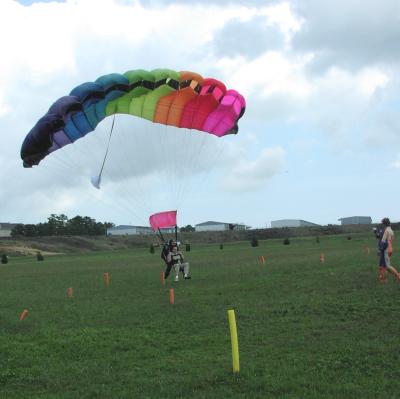 I look beneath me and
I quickly realize that we're going to need to stop this ride
soon. I then feel a mild shock, and then a strong pull, as if
someone has grabbed my belt and is dragging me backwards. A
couple seconds later and then everything goes QUIET. I let out a
"WAHOO", but it fails to capture what I'm feeling at that moment.
I start to gray out a bit, and then start to feel a bit queasy.
Rats. I knew I should have eaten breakfast. They warned me to
eat, but I never eat before I fly, and I've pulled my share of
G's on an empty stomach, so, why should this be any different?
Well, maybe because I just threw myself out of an airplane and
spent the last 45 seconds going 120 MPH straight down? Sensory
overload, and yes, anxiety, can do that to you.
I look beneath me and
I quickly realize that we're going to need to stop this ride
soon. I then feel a mild shock, and then a strong pull, as if
someone has grabbed my belt and is dragging me backwards. A
couple seconds later and then everything goes QUIET. I let out a
"WAHOO", but it fails to capture what I'm feeling at that moment.
I start to gray out a bit, and then start to feel a bit queasy.
Rats. I knew I should have eaten breakfast. They warned me to
eat, but I never eat before I fly, and I've pulled my share of
G's on an empty stomach, so, why should this be any different?
Well, maybe because I just threw myself out of an airplane and
spent the last 45 seconds going 120 MPH straight down? Sensory
overload, and yes, anxiety, can do that to you.
Willie hands me the toggles, first the left, and then the right, and I'm flying this canopy! A slight tug on the right toggle and she turns right. Willie then says "let up a bit on the right and pull the left hard". Before I know it I'm being thrown to the outside of what feels like a 2G+ turn.. At the mercy of my ailing stomach, I quickly release most of the pressure and glance down at the earth to realize we've made a 180 degree turn in virtually no time. Man, this thing is maneuverable. Then I look down at my feet and see nothing but 3000 feet or so worth of air below me. For fun, I point my toes out a bit to see if I can touch the earth. Not quite yet. But my size 11s can sure make that big corporate hangar disappear!
Touchdown!
Willie asks for the toggles back and I reluctantly transfer control back to him. We appear to circle directly over the landing spot, but I soon realize that Willie is flying a square pattern similar to what we do with airplanes. I try to judge the drift and figure out where the wind is coming from, and then glance directly below us to check the wind sock and flags to see if I'm right. I'm quiet during this whole time, just trying to take everything in. It's dead quiet throughout this entire process and I can hear myself think again. I finally realize why skydivers are so passionate about what they do. This is, for lack of a better word...awesome.
The drop zone is getting pretty big at this point, so Willie brings us around for a downwind, base, and then final approach. "Legs up", Willie commands. I do as instructed. At about 50 feet we start to flare. Touchdown happens all too soon, and Willie's legs touch first, and then mine. We're still moving a bit forward as we land, and my foot catches in the grass. I trip a bit and wind up sliding a bit before we come to rest smoothly...on our butts. :-) Willie then detached my harness from his, we got up, and shook hands. Mission accomplished!
Let's do that again!
As we walked back to the shack, I asked a few questions, including "what's next?" He explained that the standard program is another two tandem jumps (each costing slightly less than today's jump) followed by the AFF program during which I would successfully execute 7 jumps with progressively less supervision until I can do it all myself -- In other words, an appropriately cautious and structured training program not unlike first solo in an aircraft. Before that, however, I'd need to sign up for CFT (Canopy Flight Training) and the AFF course. First things first, of course.
The assistant then helped me out of my harness and I removed the jumpsuit only to watch Todd suit up and get to jump with Willie. The other guys started asking me the usual questions, and I started to relate my experience in detail, but stopped myself after I glanced over at Todd. "Well, I don't want to spoil it for you...let's just say you'll LOVE it!"
Shortly after he left in the van for his journey to the wild side, I walked around a bit and watched several of our group jump just like me. In that time I concluded that while I couldn't quite believe what I'd just done, I also couldn't imagine NOT having done it. And I can't imagine not doing it again, so I shall.
Care to join me?



